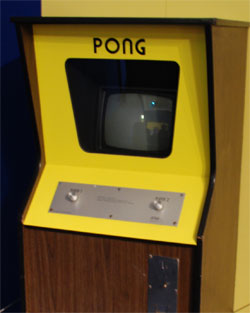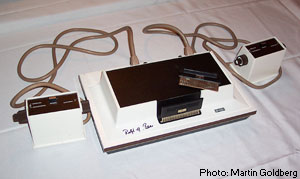 In November 1972, a heap of litter appeared in one corner of Andy Capp’s Tavern in Sunnyvale, California. Upon further inspection, however, it turned out to be a black and white television, a coin-op mechanism from a local laundrette, a largish chunk of circuit board, and a milk bottle. When correctly assembled and shoved into a small wardrobe with a hole cut into it, the telly, the circuit board and the coin op mechanism blinked into life and became Pong, the very first arcade game to appear in public, ever. The milk bottle was there to catch the coins.
In November 1972, a heap of litter appeared in one corner of Andy Capp’s Tavern in Sunnyvale, California. Upon further inspection, however, it turned out to be a black and white television, a coin-op mechanism from a local laundrette, a largish chunk of circuit board, and a milk bottle. When correctly assembled and shoved into a small wardrobe with a hole cut into it, the telly, the circuit board and the coin op mechanism blinked into life and became Pong, the very first arcade game to appear in public, ever. The milk bottle was there to catch the coins.
After an hour or so, curious drinkers started to fiddle about with it. In a very short while, the incessant beeping from the game was attracting the attention of other patrons. The next morning, there were long queues outside Andy Capp’s well before opening time, and the game was played incessantly for 12 hours, at which point it broke down due to having too many coins jammed into it. Also unsurprisingly, it started the entire gaming industry, although this would perhaps not have been obvious to the people still queuing outside and the bloke who nicked the milk bottle.
The person responsible for Pong was Allan Alcorn. Well, sort of. Alcorn, who has since had a major hand in the development of all manner of iProducts – if you like that sort of thing – inadvertently based Pong on a tennis game called Odyssey, produced the previous year by a company called Magnavox. He was given this task by one Nolan Bushnell, who had played Odyssey, and had just co-founded a small business which aimed to license gaming ideas to existing companies. The business was named after a Japanese word for ‘go’ – ‘Atari’.
Bushnell was hugely impressed with Alcorn’s creation, and pressed ahead with the commercial marketing of the game, despite Atari finding itself the subject of a lawsuit by Magnavox. Realising that the basic Pong concept was a bit, well, boring, Alcorn had added the capacity for players to hook and slice the ball all over the place by altering the angles at which a stroke would travel, according to what part of the bat had been in contact with it. The ball would also speed up during rallies, returning to a more leisurely pace one a player forfeited a point, and these features greatly lessened the chances of two players playing a single rally until the end of time.
 In the aftermath of the Andy Capp experiment, all that now remained was to take the game to the world in the aftermath of the Andy Capp success. With Magnavox and Atari fighting each other to a standstill in the courts, the two companies eventually agreed to an uneasy alliance whereby Atari would act as a licensee for Magnavox’s products. Bushell remained somewhat scornful throughout proceedings, however, stating under oath that although he had seen and played the tennis game which inspired Pong, he ‘…didn’t think it was very clever’, hence Atari’s commissioning of Alcorn’s far superior effort. Armed with Pong, Atari went on to start the home computer market with, among other things, their snazzily entitled Video Computer System, which kept the Sound Of Music and Morecombe and Wise off Christmas screens all over the US and UK as televisions were commandeered for computer tennis marathons throughout the late ’70s and early ’80s.
In the aftermath of the Andy Capp experiment, all that now remained was to take the game to the world in the aftermath of the Andy Capp success. With Magnavox and Atari fighting each other to a standstill in the courts, the two companies eventually agreed to an uneasy alliance whereby Atari would act as a licensee for Magnavox’s products. Bushell remained somewhat scornful throughout proceedings, however, stating under oath that although he had seen and played the tennis game which inspired Pong, he ‘…didn’t think it was very clever’, hence Atari’s commissioning of Alcorn’s far superior effort. Armed with Pong, Atari went on to start the home computer market with, among other things, their snazzily entitled Video Computer System, which kept the Sound Of Music and Morecombe and Wise off Christmas screens all over the US and UK as televisions were commandeered for computer tennis marathons throughout the late ’70s and early ’80s.
That, then, was Pong. Not quite the first computer game, but certainly the first commercially successful one. Barely a generation later, its legacy lives on in everything from Tamagotchi to Toy Story 3. Pong’s influence cannot be overstated: it is so everywhere that it is also nowhere. Even if you’ve never played it, you know the sound of the ball hitting the bat. That’s cultural impact for you.

Comments are closed.